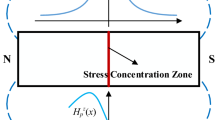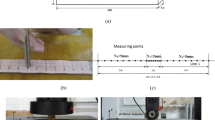Abstract
Tensile fatigue tests were designed to study the relation between the tangential magnetic memory signal and dislocations. According to experimental results, in the early stage of fatigue, the magnetic signal and the dislocation density rapidly increase; while in the middle stage, the magnetic signal gradually increases, the dislocation density remains steady, and only the dislocation structure develops. On the other hand, in the later stage, the magnetic signal once again increases rapidly, the dislocation structure continues to develop, and microscopic cracks are formed. Analysis reveals that the dislocations block the movement of the domain wall, and the area of dislocation accumulation thus becomes an internal magnetic source and scatters a field outward. In addition, the magnetic memory field strengthens with increasing dislocation density and complexity of the dislocation structure. Accordingly, the dislocation pinning factor related with the dislocation density and the dislocation structure has been proposed to characterize the effect of dislocations on the magnetic memory signal. The magnetic signal strengthens with an increase in the dislocation pinning factor.
Similar content being viewed by others
References
A.A. Dubov, Study of metal properties using metal magnetic memory method, [in]_7th European Conference on Non-destructive Testing, Copenhagen, 1998, p. 920.
H.Y. Xing, M.Q. Xu, and J.W. Li, Magnetic Memory Testing Technology and its Engineering Application, China Petrochemical Press, Beijing, 2011, pp. 1–10.
J.C. Leng, M.Q. Xu, and H.Y. Xing, Research progress of metal magnetic memory testing technique in ferromagnetic components, J. Mater. Eng., (2010), No. 11, p. 88.
Z.D. Wang, Y. Gu, and Y.S. Wang, A review of three magnetic NDT technologies, J. Magn. Magn. Mater., 324(2012),p. 382.
A. Dubov and S. Kolokolnikov, The metal magnetic memory method application for online monitoring of damage development in steel pipes and welded joints specimens, Weld World, 57(2013),p. 123.
J.C. Leng, M.Q. Xu, M.X. Xu, and J.Z. Zhang, Magnetic field variation induced by cyclic bending stress, NDT & E Int., 42(2009), No. 5, p. 410.
J.W. Li, Z. Su, G.P. Lv, Z.G. Wang, and C. Tian, The variation of surface magnetic field induced by fatigue stress, J. Nondestruct. Eval., 32(2013),p. 238.
M.X. Xu, Z.H. Chen, and M.Q. Xu, Magnetic memory signal characteristic of metal under fatigue load, J. Univ. Sci. Technol. Beijing, 35(2013), No. 12, p. 1615.
Y.L. Zhang, R.B. Gou, J.M. Li, G.T. Shen, and Y.J. Zeng, Characteristics of metal magnetic memory signals of different steels in high cycle fatigue tests, Fatigue Fract. Eng. Mater. Struct., 35(2012),p. 595.
H.H. Huang, R.J. Liu, X. Zhang, Y. Wang, and Z.F. Liu, Magnetic memory testing towards fatigue crack propagation of 510L steel, J. Mech. Eng., 49(2013), No. 1, p. 135.
J.W. Li and M.X. Xu, Modified Jiles-Atherton-Sablik model for asymmetry in magnetomechanical effect under tensile and compressive stress, J. Appl. Phys., 110 (2011), No. 6, art. No. 063918.
Z.D. Wang, B. Deng, and K. Yao, Physical model of plastic deformation on magnetization in ferromagnetic materials, J. Appl. Phys., 109(2011), No. 8, art. No. 083928.
M.X. Xu, M.Q. Xu, J.W. Li,, S.S. Ma, and H.Y. Xing, Discuss on using Jiles-Atherton theory for charactering magnetic memory effect, J. Appl. Phys., 112(2012), No. 9, art. No. 093902.
L.J. Yang, B. Liu, L.J. Chen, and S.W. Gao, The quantitative interpretation by measurement using the magnetic memory method (MMM)-based on density functional theory, NDT & E Int., 55(2013),p. 15.
D.Y. Zhang, Investigations of Microstructure and Magnetic Domain during Uniaxial Tensile for Pressure Vessel Steel [Dissertation], Beijing University of Technology, Beijing, 2011, p. 59.
M. Roskosz, Metal magnetic memory testing of welded joints of ferritic and austenitic steels, NDT & E Int., 44(2011),p. 305.
P.L. Liu, W.Y. Chu, and L.J. Qiao, Phase field simulation of the 180° domain-switching process in PbTiO3 single crystal under an antiparallel electric field, Int. J. Miner. Metall. Mater., 17(2010), No. 4, p. 494.
J. Noodam, C. Sirisathitkul, N. Matan, W. Rattanasakulthong, and P. Jantaratana, Magnetic properties of NdFeB-coated rubberwood composites, Int. J. Miner. Metall. Mater., 20(2013), No. 1, p. 65.
X.S. Jiang, G.Q. He, B. Liu, Z.Y. Zhu, and W.H. Zhang, Fatigue characteristics and microcosmic mechanism of Al-Si-Mg alloys under multiaxial proportional loadings, Int. J. Miner. Metall. Mater., 18(2011), No. 4, p. 437.
M. Roskosz and P. Gawrilenko, Analysis of changes in residual magnetic field in loaded notched samples, NDT & E Int., 41(2008), No. 7, p. 570.
J.W. Wilson, G.Y. Tian, and S. Barrans, Residual magnetic field sensing for stress measurement, Sens. Actuators A, 135(2007), No. 2, p. 381.
D. Feng, Metal Physics (Book Four): Superconductivity and Magnetism, Science Press, Beijing, 2000, pp. 95–113, pp. 545–560.
D.F. Yuan and X. L. Ma, Magnetism Physics, University of Electronic Science & Technology Press, Chengdu, 1994, pp. 286–300.
J.L. Ren and J.M. Lin, Metal Magnetic Memory Testing Technique, China Electric Power Press, Beijing, 2000, pp. 1–30.
Author information
Authors and Affiliations
Corresponding author
Rights and permissions
About this article
Cite this article
Xu, Mx., Chen, Zh. & Xu, Mq. Micro-mechanism of metal magnetic memory signal variation during fatigue. Int J Miner Metall Mater 21, 259–265 (2014). https://doi.org/10.1007/s12613-014-0903-z
Received:
Revised:
Accepted:
Published:
Issue Date:
DOI: https://doi.org/10.1007/s12613-014-0903-z




